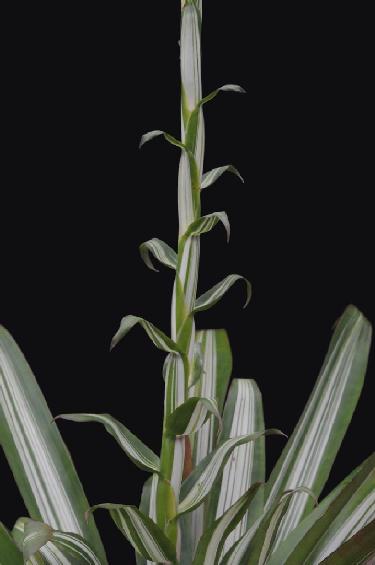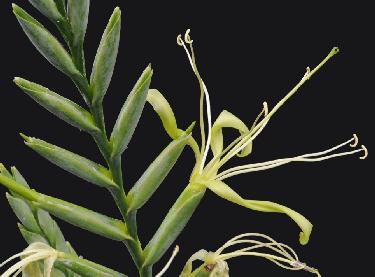



This started about 10 years ago when Mick Romanowski talked about this variegated Tillandsia viridiflora he had that flowered with a branched inflorescence and not like the single inflorescence of his ‘normal’ T. viridiflora. I assured him not to worry because the description in Smith & Downs said the inflorescence could be either simple or branched.
In 2007 I heard rumblings from Renate Ehlers about this branched plant she had found which seemed to be a species in its own right and she even got the Mexicans to agree that it was the long lost T. macropetala and that the name should be resurrected from synonymity under T. viridiflora. This had me checking the old records and this is what I came up with:
“Tillandsia macropetala Wawra, Wiener III. Gart. 12: 241, Fig. 50. 1887. Type. Vienna Hortus ex E. Morren s n (n v). Identified by description and illustration.
Translated by Butcher
A magnificent plant 1˝ metres high, formed by a rosette of leaves, around the base of the shaft, virtually 1 metre in diameter; its massive of wide pale red sheaths unite in an oval bulb; its lanceolate leaf blades spreading in a dainty bow, as you look downwards; they taper to a fine tip, a lively green, matt, both sides about the same colour and with faint darker stains and markings. The innermost leaves erect, are smaller and narrower, and merge into the scape bracts above.
The Inflorescence is very long and, very poorly branched Panicle; the Panicle scape is strictly erect, as thick as your thumb and covered over with bracts; the lowermost bracts are leaf-like, the upper ones quickly becoming shorter to about 4 cm long and oblong, keeps the colour of the leaves until the top which is brownish on the outside; they nestle narrowly on the scape, however the acuminate tip is spreading giving the stem a quite rough look. The bracts are very dense at the lower half and imbricate, then they move apart more, so that the scape remains uncovered to the node, at the same time they become thinner and lanceolate; the uppermost are appressed to the stem.
The branches, with our plant three at number, are almost at right angles where they branch off, bending soon upward, shorter than the top spike, always simple and with a primary bract similar to the scape bracts but somewhat wider, and solidly appressed to the branch.
The flowers are densely distichously arranged on the branches, but clearly move apart after anthesis. The floral bracts are similar to the scape bracts, only they are rounder and a little bigger than these; the lowermost are sterile. The flowers are sessile, which with the floral bract are joined on a short stalk.
The calyx is a rounded stem and exactly as long as the bract but appears about as long as the exserted stem. Sepals are pale green, only at the outer tip are some brownish and hardly marked.
The pale yellow petals overhang (to my knowledge) those of all other Tillandsias and Vrieseas, they become 12 cm long; the lower ones are smaller, in the calyx half they are very narrow and the edges are imbricate, and form with the sepals a spiralling tube; the upper larger half is similarly wider so that they become fully 2cm wide below the rounded off tip. The petals are far apart and after anthesis hang laxly downwards; they are delicate and, (in subdued light) many nerved. The nerves run parallel, bending downwards towards and disappearing near the petal edge, without anastomosis. Nectaries missing at the base. The filaments straight, prominent, quite free, and about 2 cm longer than the corolla. The anthers are long, very narrow some over 1cm, (pollen gold-yellow), blunt at both ends, attached in its lower third, then split; lying near the fold.
The oblong smooth, with a slimy mass of outercoating Ovary, tapering into the threadlike style above. This is stronger than the filaments, and the tips are bent downwards, blunt triangular and exceeding the filament by about 2cm, therefore 16 cm long. The leaflike wide stigma lobes are lanceolate, blunt, green and spiral. The linear placenta have many rows, narrow short stemmed, of short stringed seeds.
Habitat: Mexico.
The illustration of this plant (larger in real life), with a leaf and a flower came to me from Liege from my unforgettable friend, the highly regarded botanical and particularly Bromeliaceae expert Professor Morren, a few days after his passing away. Morren seems to have shown great interest in the solution to the problem as to whether this was a new species because of its unique vegetative organs; it was not for him to experience the development of the flower. The expectation of Morren's was amply justified. The plant proved to be a new species, which is mainly based on the very long petals from the other Tillandsias (and Vrieseas). But it shows another peculiarity; our plant has completely the habit of a Vriesea but lacks the honey-scales at the base of the petals. The existence of these scales in Vriesea forms the only decisive, because the flower is different to Tillandsia; for the time being I believe this is a new species and name it Tillandsia macropetala because of its very long petals, after deciding to leave the proof as to whether it was a Vriesea or Tillandsia until later. I can only say that so far I cannot decide categorically that honey-scales constitute a Vriesea. Bentham and Hoocker (gene.) admittedly put no big weight on the same and unify both genera under Tillandsia. The entirely different look of that to Vriesea does not appear to justify such an amalgamation in the manner paid to Tillandsia without dividing a natural group. It remains to be seen whether we look for a new difference, whether in the flower or fruit, to take notice of the vegetative organs, incidentally where I had very little material to work with - the examination could be planned only on one single, wilted flower - that maybe tiny scales are the answer.”
So we now know what the non-variegated form looks like and this is the one that will eventually be published because the writers are only interested in this plant found in the wild. Remember too that when Reed S. Beaman and Walter S. Judd reviewed the species in Brittonia 48(1): 1-19. 1996 no mention was made of the variegated variety. Taxonomists try to stay clear of variegated plants because they rarely reproduce in the wild from seed. Their reproduction is asexual and there is no one in the wild to move offsets around. Only in cultivation does variegation get selected from offsets, improved on, and circulated.
What about the T. viridiflora var. variegata which was described as:
Tillandsia viridiflora (Beer) Baker, var. variegata W. Seaborn, J Brom Soc 29 : 182 . 1979
A var. viridiflora foliis variegatis differt.
Type: Cultivated W. Seaborn s n (US).
In cultivation this plant picks up a dark red diffusion. The plant was found in the Jalapa, Vera Cruz, Mexico area, 1968.
The photograph clearly shows this is the branched inflorescence form and links to the variegated form that eventually got to Australia. So this plant will be in limboland as to a name because it does not link to T. viridiflora (Beer) Baker in the strict sense.
My interest in this cultivar was triggered by a recent photo of a flowering plant from Peter Tristram from Repton, NSW. I then found out that Mick Romanowski was not the only Victorian growing this plant and had to add Chris Larson to the list. No doubt there are many other Australians growing this plant. I felt it needed a name but it is useless giving a name to a plant for it to be ignored which is why I got growers of this plant involved in the discussion. I asked Margaret for a name – she is good at these sorts of things – and we came up with ‘Silver Candelabra’.
Just one word of warning. Even though the plant has been in Australia say over 30 years the adventitious offsets you can expect at the base are many and varied. It is suggested that you only select the variegated ones. If you don’t then you will have to call them ‘Silver Candelabra Novar’ - in other words No variegation!! but if grown on they are just as likely to produce some variegated adventitious offsets!



